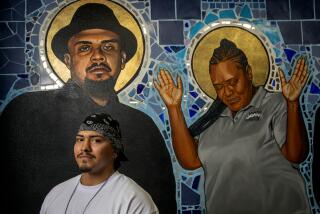A Place Where Nonprofit Means Business
- Share via
KANSAS CITY, Mo. — So little known is American Humanics Inc. in its hometown that when attorney David Oliver was asked to join its board of directors in 1994, he didn’t know what the nonprofit organization did.
“I’d really never heard of it,” said Oliver, now president of the board. “I asked people about it and they said, ‘Well, it’s kind of behind the times. It’s just kind of chugging along.’ ”
But in the past five years, the one-of-a-kind corporation has gained stature as a premier provider of entry-level professionals for such national nonprofit agencies as the YMCA and YWCA, Habitat for Humanity, Catholic Charities USA and Boys & Girls Clubs of America.
Through programs on 65 college and university campuses--up from only 15 in 1995--American Humanics trains and certifies undergraduates in skills critical to managing nonprofit organizations that serve youth and families.
Business Principles for Nonprofit Groups
The course work, the minimum 300-hour internships and related activities required for certification are designed to give students knowledge of business principles and their application to nonprofit groups.
Boys & Girls Clubs of America, which is opening an average of one new club each weekday, an American Humanics certificate is an invaluable qualification.
“There are specific skills and understanding that people need to be leaders of not-for-profts,” said Roxanne Spillett, president of Atlanta-based Boys & Girls Clubs of America, which serves 3.3 million youngsters in about 2,500 clubs.
“They need to understand the mission and to have a deep belief and passion for it. But they also need skills not unlike those in business, such as budgeting, fund-raising, board development, managing people.”
That combination of education and attitude was what H. Roe Bartle, later to become Kansas City’s mayor, was looking for when he founded American Humanics in 1948. (The fanciful name he gave his organization--”humanics” is not in dictionaries--was in keeping with Bartle’s colorful style.)
A longtime Boy Scout executive, Bartle was constantly hunting for young professionals to work in the organization. There was no shortage of young people with their hearts in the right places, but those inclined toward nonprofit careers tended to have only a glancing acquaintance with business and management.
From the start, American Humanics worked with colleges and universities willing to offer undergraduate courses in management of nonprofits, with professionals giving lectures and workshops. Students were required to volunteer in community agencies, gaining practical experience.
But over the years, American Humanics signed up just a dozen colleges and universities as partners, and by 1992, its directors wondered whether the organization was worth sustaining. But they went ahead and hired Kirk G. Alliman, then president of Hesston College in Hesston, Kan., to serve as president.
“When the board brought me in for an interview, they said, ‘We’re looking for someone who can give us our best, last shot. And if you’re hired, give it your best, and tell us, if we haven’t figured it out by then, whether we should shut the doors or continue on,’ ” Alliman said.
Greater Demand for Social Services
A painstaking two-year review of American Humanics’ mission and methods produced some heartening conclusions.
First, employment growth in the nonprofit sector was projected to outstrip that of the for-profit and government sectors over the next 15 years as demand for social services surged.
Second, although federal funding, the lifeblood of charitable nonprofits, was declining, corporate donations were making up the difference in funding. Corporations wanted focus, efficiency and accountability in return.
“My series of interviews with the CEOs of our national not-for-profit organizations revealed a tremendous need for this program,” Alliman said. “The coming together of those dynamics and my particular interests and capabilities seemed to mesh well with what this organization could become.”
American Humanics set out to increase its presence at colleges and universities, dispatching its new campus expansion director, Phyllis Wallace, to schools across the country. Wallace helped recruit dozens of schools, who hired campus directors and increased their own efforts to attract students, particularly minority and nontraditional students.
Such diversity is evident in the Humanics program at Kansas City’s Rockhurst University, where Gene Dooley, president and CEO of the YMCA of Greater Kansas City, teaches an introductory course in nonprofit management.
Along with about 20 juniors and seniors, Dooley’s class last fall included a half-dozen adults preparing for new careers in nonprofit agencies.
“They’re now looking to give something back,” said Dooley, who has hired 11 Humanics graduates over the years and considers the program “a talent pool for nonprofits.”
Dooley’s students last fall included 49-year-old Khawaja AzZubair, a mother of seven, and full-time clerk on the overnight shift at the U.S. Postal Service. She is pursuing a bachelor’s degree along with her Humanics certificate, and aims eventually for a master’s degree.
“I had been looking for some way of giving back, of doing something for people. It’s in line with my religious beliefs,” said Az-Zubair, a board member of the Crescent Peace Society, an Islamic group. “My children were grown, and it seemed like the time was right.”
Az-Zubair, whose husband is a director of the local AmeriCorps volunteer program, plans to work as a fund-raising for a nonprofit agency serving youth and families.
Erika Dixon, a 19-year-old junior majoring in marketing and psychology, took Dooley’s course “to get exposure to nonprofits and see if maybe this is the route I want to go.” So far, what she’s seen through the American Humanics program is attractive: Next summer, Dixon will be a fund-raising assistant for Catholic Charities.
More to Read
Inside the business of entertainment
The Wide Shot brings you news, analysis and insights on everything from streaming wars to production — and what it all means for the future.
You may occasionally receive promotional content from the Los Angeles Times.










